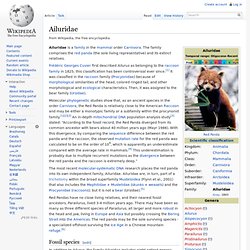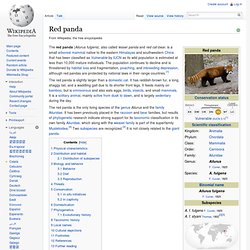

Red panda videos, photos and facts - Ailurus fulgens. Predominately solitary, red pandas are most active at dawn and dusk (5).

They have semi-retractable claws, which allow them to be efficient climbers and when not foraging, pandas are usually found in the trees. Males occupy territories that overlap those of several females, especially in the mating season (4), and territories of both sexes are marked with anal secretions (5). Red pandas mate on the ground but the female gives birth, usually to two young, within a hollow tree nest cavity (5). Young are born blind and helpless, opening their eyes after 18 days (5). Ailuridae. Molecular phylogenetic studies show that, as an ancient species in the order Carnivora, the Red Panda is relatively close to the American Raccoon and may be either a monotypic family or a subfamily within the procynonid family.[1][2][3] An in-depth mitochondrial DNA population analysis study[3] stated: “According to the fossil record, the Red Panda diverged from its common ancestor with bears about 40 million years ago (Mayr 1986).

With this divergence, by comparing the sequence difference between the red panda and the raccoon, the observed mutation rate for the red panda was calculated to be on the order of 109, which is apparently an underestimate compared with the average rate in mammals.[4] This underestimation is probably due to multiple recurrent mutations as the divergence between the red panda and the raccoon is extremely deep.” The most recent molecular-systematic DNA research places the red panda into its own independent family, Ailuridae. Fossil species[edit] References[edit] Red panda. The red panda (Ailurus fulgens), also called lesser panda and red cat-bear, is a small arboreal mammal native to the eastern Himalayas and southwestern China that has been classified as Vulnerable by IUCN as its wild population is estimated at less than 10,000 mature individuals.

The population continues to decline and is threatened by habitat loss and fragmentation, poaching, and inbreeding depression, although red pandas are protected by national laws in their range countries.[1] The red panda is slightly larger than a domestic cat. It has reddish-brown fur, a long, shaggy tail, and a waddling gait due to its shorter front legs. It feeds mainly on bamboo, but is omnivorous and also eats eggs, birds, insects, and small mammals. It is a solitary animal, mainly active from dusk to dawn, and is largely sedentary during the day.